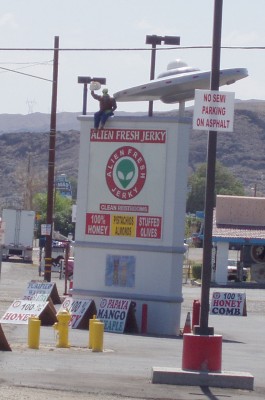You know the routine. We can’t pass up a bizarre image without taking a photo and posting some sort of comment. Not even on vacations.
 The drive to Las Vegas from southern California is simple: make your way to the 15, head north, and keep going until you get blinded by the neon. The ⅔ mark is Baker, CA, a small strip of restaurants, stores and gas stations in the middle of the desert, famous for the Bun Boy and the world’s tallest thermometer. Baker has something new: Alien Fresh Jerky.
The drive to Las Vegas from southern California is simple: make your way to the 15, head north, and keep going until you get blinded by the neon. The ⅔ mark is Baker, CA, a small strip of restaurants, stores and gas stations in the middle of the desert, famous for the Bun Boy and the world’s tallest thermometer. Baker has something new: Alien Fresh Jerky.
We were staying at the South Coast Hotel and Casino, the latest megasino to open, which is a bit off the strip. At first I was a bit worried about finding the right exit. As it turns out, it’s the first giant hotel you’ll see as you approach Las Vegas from the south…about two miles before you actually have a chance to get off the freeway! (They have a free shuttle to the strip, though that had its own share of problems.) They put us in a room on the 24th floor, which had a great view of suburban South Las Vegas. Continue reading
